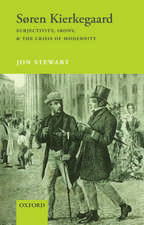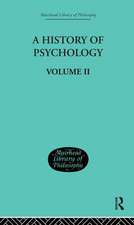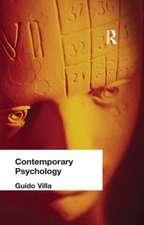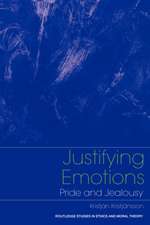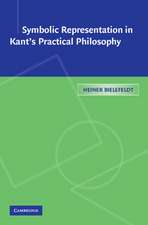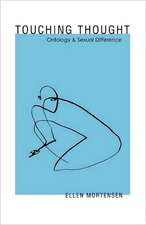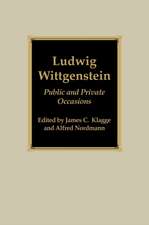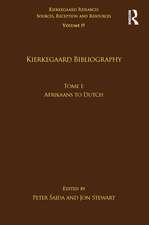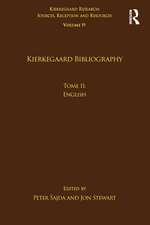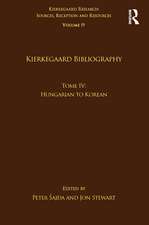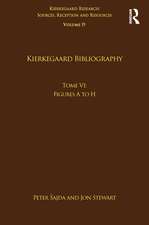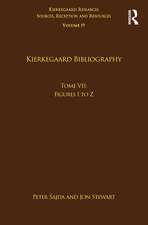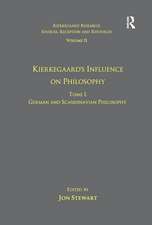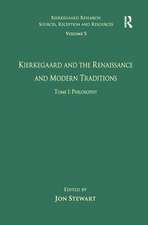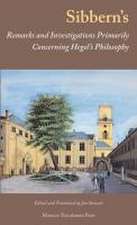Volume 3: Kierkegaard and the Roman World: Kierkegaard Research: Sources, Reception and Resources
Editat de Jon Stewarten Limba Engleză Hardback – 28 apr 2009
| Toate formatele și edițiile | Preț | Express |
|---|---|---|
| Paperback (1) | 469.34 lei 6-8 săpt. | |
| Taylor & Francis – 11 noi 2016 | 469.34 lei 6-8 săpt. | |
| Hardback (1) | 1058.65 lei 6-8 săpt. | |
| Taylor & Francis – 28 apr 2009 | 1058.65 lei 6-8 săpt. |
Din seria Kierkegaard Research: Sources, Reception and Resources
-
 Preț: 310.71 lei
Preț: 310.71 lei -
 Preț: 386.77 lei
Preț: 386.77 lei - 18%
 Preț: 1055.21 lei
Preț: 1055.21 lei - 18%
 Preț: 1065.78 lei
Preț: 1065.78 lei - 26%
 Preț: 820.71 lei
Preț: 820.71 lei - 18%
 Preț: 1064.19 lei
Preț: 1064.19 lei - 18%
 Preț: 1060.87 lei
Preț: 1060.87 lei - 25%
 Preț: 826.15 lei
Preț: 826.15 lei - 18%
 Preț: 1071.27 lei
Preț: 1071.27 lei -
 Preț: 469.34 lei
Preț: 469.34 lei - 18%
 Preț: 1059.84 lei
Preț: 1059.84 lei - 15%
 Preț: 703.76 lei
Preț: 703.76 lei - 18%
 Preț: 1117.49 lei
Preț: 1117.49 lei - 18%
 Preț: 1054.71 lei
Preț: 1054.71 lei - 18%
 Preț: 1116.27 lei
Preț: 1116.27 lei -
 Preț: 381.28 lei
Preț: 381.28 lei - 26%
 Preț: 765.59 lei
Preț: 765.59 lei - 25%
 Preț: 825.63 lei
Preț: 825.63 lei - 26%
 Preț: 821.13 lei
Preț: 821.13 lei -
 Preț: 469.34 lei
Preț: 469.34 lei - 18%
 Preț: 1061.81 lei
Preț: 1061.81 lei - 18%
 Preț: 1062.31 lei
Preț: 1062.31 lei - 18%
 Preț: 1061.81 lei
Preț: 1061.81 lei - 18%
 Preț: 1059.45 lei
Preț: 1059.45 lei - 18%
 Preț: 1059.45 lei
Preț: 1059.45 lei - 18%
 Preț: 1060.25 lei
Preț: 1060.25 lei -
 Preț: 489.26 lei
Preț: 489.26 lei - 25%
 Preț: 768.82 lei
Preț: 768.82 lei - 18%
 Preț: 1116.77 lei
Preț: 1116.77 lei - 18%
 Preț: 1112.03 lei
Preț: 1112.03 lei - 18%
 Preț: 1067.35 lei
Preț: 1067.35 lei - 18%
 Preț: 1056.00 lei
Preț: 1056.00 lei - 25%
 Preț: 768.82 lei
Preț: 768.82 lei - 18%
 Preț: 1064.98 lei
Preț: 1064.98 lei - 25%
 Preț: 769.69 lei
Preț: 769.69 lei - 18%
 Preț: 1061.06 lei
Preț: 1061.06 lei - 26%
 Preț: 820.32 lei
Preț: 820.32 lei - 25%
 Preț: 823.17 lei
Preț: 823.17 lei - 26%
 Preț: 821.94 lei
Preț: 821.94 lei - 26%
 Preț: 821.53 lei
Preț: 821.53 lei - 18%
 Preț: 1064.19 lei
Preț: 1064.19 lei - 18%
 Preț: 1057.26 lei
Preț: 1057.26 lei - 26%
 Preț: 850.73 lei
Preț: 850.73 lei - 18%
 Preț: 1054.71 lei
Preț: 1054.71 lei - 25%
 Preț: 854.26 lei
Preț: 854.26 lei
Preț: 1058.65 lei
Preț vechi: 1291.04 lei
-18% Nou
Puncte Express: 1588
Preț estimativ în valută:
202.58€ • 208.99$ • 169.05£
202.58€ • 208.99$ • 169.05£
Carte tipărită la comandă
Livrare economică 26 martie-09 aprilie
Preluare comenzi: 021 569.72.76
Specificații
ISBN-13: 9780754665540
ISBN-10: 0754665542
Pagini: 248
Dimensiuni: 156 x 234 x 16 mm
Greutate: 0.57 kg
Ediția:New.
Editura: Taylor & Francis
Colecția Routledge
Seria Kierkegaard Research: Sources, Reception and Resources
Locul publicării:Oxford, United Kingdom
ISBN-10: 0754665542
Pagini: 248
Dimensiuni: 156 x 234 x 16 mm
Greutate: 0.57 kg
Ediția:New.
Editura: Taylor & Francis
Colecția Routledge
Seria Kierkegaard Research: Sources, Reception and Resources
Locul publicării:Oxford, United Kingdom
Cuprins
Contents: Preface; Apuleius: direct and possible indirect influences on the thought of Kierkegaard, Stacey E. Ake; Cicero: a handy Roman companion: Marcus Tullius Cicero's appearance in Kierkegaard's works, Thomas Eske Rasmussen; Horace: the art of poetry and the search for the good life, Thomas Miles; Livy: The History of Rome in Kierkegaard's works, Nataliya Vorobyova; Marcus Aurelius: Kierkegaard's use and abuse of the stoic emperor, Rick Anthony Furtak; Nepos: traces of Kierkegaard's use of an edifying Roman biographer, Jon Stewart; Ovid: of love and exile: Kierkegaard's appropriation of Ovid, Steven P. Sondrup; Sallust: Kierkegaard's scarce use of a great Roman historian, Niels W. Bruun; Seneca: Disjecta Membra in Kierkegaard's writings, Niels W. Brunn; Suetonius: exemplars of truth and madness: Kierkegaard's proverbial uses of Suetonius' Lives, Sebastian Høeg Gulmann; Tacitus: Christianity as odium generis humani, Jon Stewart; Terence: traces of Roman comedy in Kierkegaard's writings, Mikkel Larsen; Valerius Maximus: moral Exempla in Kierkegaard's writings, Nataliya Vorobyova; Virgil: from farms to empire: Kierkegaard's understanding of a Roman poet, Steven P. Sondrup; Indexes.
Notă biografică
Jon Stewart is an Associate Research Professor in the Søren Kierkegaard Research Centre at the University of Copenhagen, Denmark.
Descriere
While Kierkegaard's use of the Greek authors, particularly Plato and Aristotle, has attracted considerable attention over the years, his use of the Roman authors has, by contrast, remained sadly neglected. This neglect is somewhat surprising given the fact that Kierkegaard was extremely well read in Latin from his early youth when he attended the Borgerdyd School in Copenhagen. Kierkegaard's interest in the Roman authors is perhaps best evidenced by his book collection. In his private library he had a long list of Latin titles and Danish translations of the standard Roman authors in any number of different genres. His extensive and frequent use of writers such as Cicero, Horace, Terence, Seneca, Suetonius and Ovid clearly warrants placing them in the select group of his major sources. The chapters in this volume demonstrate that Kierkegaard made use of the Roman sources in a number of different ways. His readings from the school seem to have stuck with him as an adult. He constantly refers to Roman authors, such as Livy, Nepos, and Suetonius for colourful stories and anecdotes. In short, the Roman authors serve to enrich any number of different aspects of Kierkegaard's authorship with respect to both content and form.

